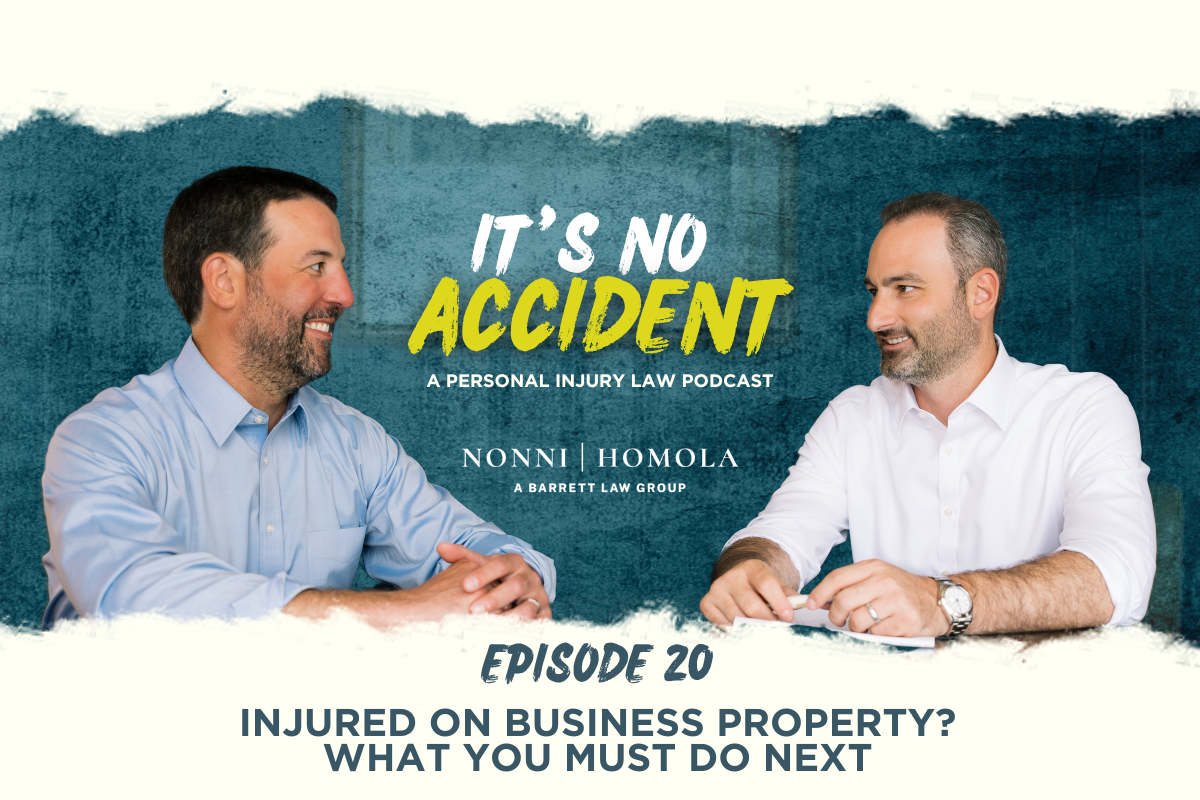
Episode Description
In this episode of It’s No Accident, attorneys Jaeson Homola and Mark Nonni shift the focus from car accidents to injuries that happen on commercial properties, such as slip and falls, falling merchandise, or other hazards inside stores and businesses. They outline key steps that can make a big impact on a case, including reporting the incident, gathering witness details, taking photos or video, and preserving items like shoes or clothing that could serve as evidence.
They also highlight common mistakes people often make after these types of accidents, like walking away without saying anything, assuming security footage will cover everything, or trusting that store reports will support their version of events. With years of experience handling premises liability claims, Jaeson and Mark explain how even small details can play a major role in building a strong case.
Episode Transcript
In a lot of these podcasts, we talk about car crashes—because that’s a big portion of the cases we handle. But we also take on a good number of premises liability cases: slip-and-falls, trip-and-falls, and really any situation where someone gets hurt at a commercial establishment because of negligence.
It’s not just falls—we’ve seen shelves collapse, items falling on people, and all kinds of similar incidents. Over the years, we’ve learned a lot about what people should do—and what they should avoid—if they’re ever injured in this type of situation. These are things we often wish clients had done differently after a fall.
So, what are some of the most important tips?
1. Don’t leave without reporting the incident.
It seems simple, but many clients admit they were embarrassed and just walked out. Later, when injuries show up, they want to pursue a claim—but without a report, it’s much harder to prove. If you can’t get up, have a witness notify an employee. If you can walk, find an associate and let them know what happened. Stores should have protocols for documenting incidents, including the time, location, what caused the fall, and any witness statements. If you leave without reporting, all of that evidence disappears.
2. Understand the risks of waiting.
Yes, many stores have cameras, but not every inch of the building is covered, and not all cameras record continuously. If you wait several days before reporting, it may look suspicious, and evidence may be gone. Juries are skeptical if you didn’t think the injury was serious enough to tell someone right away.
3. Identify witnesses.
Don’t assume the store will collect their names. Witnesses often walk away quickly, not wanting to wait for reports. At the very least, get their names and phone numbers so they can be contacted later. Without witnesses, it becomes your word against the store’s.
4. Don’t rely on the store’s incident report.
Clients often expect incident reports to support their claims, but these documents are created to protect the store, not the injured person. They’re typically considered “work product,” meaning you may never even see them. If possible, ask to fill out the report yourself, or at least ask for a copy. Sometimes an employee might let you take a quick picture with your phone—that can be invaluable.
5. Take photos and videos.
If you slipped on a substance or tripped over a hazard, photograph it. Many people assume their lawyer can just get the store’s surveillance video. The truth is, you usually can’t get that footage until a lawsuit is filed, and even then it can become a long fight over when it gets turned over. Taking your own photos immediately puts you in a much stronger position.
6. Ask employees questions.
Sometimes the best evidence comes from employee admissions. If you fell because of a spill, ask how long it’s been there or why it hasn’t been cleaned. We’ve had cases where employees admitted they were told to fix something days earlier but never did. That kind of statement can make or break a case.
7. Preserve physical evidence.
If grease, oil, or another substance got on your clothes, don’t wash them—save them in a bag. Keep the shoes you were wearing, especially if they had good tread. Defendants often argue there was nothing on the ground or blame the shoes. Having stained clothing and proper footwear as evidence helps prove your case.
The takeaway: More evidence is always better. Reporting the incident, identifying witnesses, taking photos, saving clothing and shoes—all of these things make your case much stronger and easier to prove.


